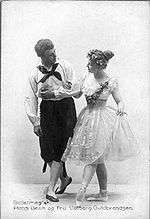Flower Festival in Genzano

The Flower Festival in Genzano (Danish: Blomsterfesten i Genzano) is a one-act ballet by Danish choreographer and ballet master August Bournonville (1805–1879). Bournonville created the work for Denmark's Royal Ballet in 1858 on the basis of the general enthusiasm among Danes for Italy. The libretto is adapted from a tale found in Impressions de voyage by Alexandre Dumas and tells the story of a pair of young lovers, Rosa and Paolo. The music is by Edvard Helsted and Holger Simon Paulli.
Background
The ballet premiered 19 December 1858 in Copenhagen and was danced in its entirety by Denmarks' Royal Ballet until 1929 when it was dropped from the repertoire. The pas de deux was extracted from one of the ensemble dances and lived on in Denmark's Royal Ballet School until Harald Lander, director of the Royal Ballet, once again brought it to the stage in 1949. It is considered one of Bournonville's most perfect compositions, a charming love duet between two young people where the steps express both their joy and their teasing playfulness. It is often performed at ballet galas to showcase the Bournonville style.
Music

The so-called Flower Festival in Genzano pas de deux has become an extremely popular repertory piece with ballet companies and is often utilized in whole or in part by dancers on the ballet competition circuit. The music of this pas de deux is often erroneously credited to Holger Simon Pauli and/or Eduard Helsted in modern theatre programs, films, etc. The true origins of this famous pas de deux stem from an 1842 staging of Bournonville's Napoli for the ballet of the Kärntnertortheater in Vienna. For this production, the danseur Lorenzo Vienna—who performed the principal role of Gennaro in Napoli—created a pas de deux for the third act to new music by the Austrian composer Matthias Strebinger (1807–1874). Bournonville then added the pas de deux to the full-length The Flower Festival in Genzano and the composer of that work, Holger Simon Pauli, adapted Strebinger's music accordingly.
The entrée of the pas de deux opens with an episode for solo violin, followed by a polka-like section. After the adage follows the male variation—this is set to a waltz taken from Adolphe Adam's score for Joseph Mazilier's 1845 ballet Le Diable à quatre. The series of relatively short, tuneful passages continues and the pas de deux concludes with a characteristic coda. The music is completely representative of ballet music from the period.
See also
References
- ↑ Terry, Walter. The King's Ballet Master: A Biography of Denmark's August Bournonville. New York: Dodd, Mead, & Company, 1979. ISBN 0-396-07722-6.